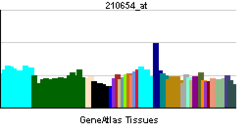Decoy receptor 2
| View/Edit Human | |||
Decoy receptor 2 (DCR2), also known as TRAIL receptor 4 (TRAILR4) and tumor necrosis factor receptor superfamily member 10D (TNFRSF10D), is a human cell surface receptor of the TNF-receptor superfamily.[2][3][4]
Function
The protein encoded by this gene is a member of the TNF-receptor superfamily. This receptor contains an extracellular TRAIL-binding domain, a transmembrane domain, and a truncated cytoplasmic death domain. This receptor does not induce apoptosis, and has been shown to play an inhibitory role in TRAIL-induced cell apoptosis.[4]
References
- ↑ "Human PubMed Reference:".
- ↑ Marsters SA, Sheridan JP, Pitti RM, Huang A, Skubatch M, Baldwin D, Yuan J, Gurney A, Goddard AD, Godowski P, Ashkenazi A (Feb 1998). "A novel receptor for Apo2L/TRAIL contains a truncated death domain". Curr Biol. 7 (12): 1003–6. doi:10.1016/S0960-9822(06)00422-2. PMID 9382840.
- ↑ Pan G, Ni J, Yu G, Wei YF, Dixit VM (Apr 1998). "TRUNDD, a new member of the TRAIL receptor family that antagonizes TRAIL signalling". FEBS Lett. 424 (1-2): 41–5. doi:10.1016/S0014-5793(98)00135-5. PMID 9537512.
- 1 2 "Entrez Gene: TNFRSF10D tumor necrosis factor receptor superfamily, member 10d, decoy with truncated death domain".
Further reading
- Kimberley FC, Screaton GR (2005). "Following a TRAIL: update on a ligand and its five receptors.". Cell Res. 14 (5): 359–72. doi:10.1038/sj.cr.7290236. PMID 15538968.
- Degli-Esposti MA, Dougall WC, Smolak PJ, et al. (1998). "The novel receptor TRAIL-R4 induces NF-kappaB and protects against TRAIL-mediated apoptosis, yet retains an incomplete death domain.". Immunity. 7 (6): 813–20. doi:10.1016/S1074-7613(00)80399-4. PMID 9430226.
- Phillips TA, Ni J, Pan G, et al. (1999). "TRAIL (Apo-2L) and TRAIL receptors in human placentas: implications for immune privilege.". J. Immunol. 162 (10): 6053–9. PMID 10229846.
- Zhang XD, Franco AV, Nguyen T, et al. (2000). "Differential localization and regulation of death and decoy receptors for TNF-related apoptosis-inducing ligand (TRAIL) in human melanoma cells.". J. Immunol. 164 (8): 3961–70. doi:10.4049/jimmunol.164.8.3961. PMID 10754286.
- Daigle I, Simon HU (2001). "Alternative functions for TRAIL receptors in eosinophils and neutrophils.". Swiss Medical Weekly. 131 (17-18): 231–7. PMID 11420819.
- Dörr J, Bechmann I, Waiczies S, et al. (2002). "Lack of tumor necrosis factor-related apoptosis-inducing ligand but presence of its receptors in the human brain.". J. Neurosci. 22 (4): RC209. PMID 11844843.
- Sun SY, Yue P, Chen X, et al. (2002). "The synthetic retinoid CD437 selectively induces apoptosis in human lung cancer cells while sparing normal human lung epithelial cells.". Cancer Res. 62 (8): 2430–6. PMID 11956107.
- Matysiak M, Jurewicz A, Jaskolski D, Selmaj K (2002). "TRAIL induces death of human oligodendrocytes isolated from adult brain.". Brain. 125 (Pt 11): 2469–80. doi:10.1093/brain/awf254. PMID 12390973.
- Robertson NM, Zangrilli JG, Steplewski A, et al. (2003). "Differential expression of TRAIL and TRAIL receptors in allergic asthmatics following segmental antigen challenge: evidence for a role of TRAIL in eosinophil survival.". J. Immunol. 169 (10): 5986–96. doi:10.4049/jimmunol.169.10.5986. PMID 12421985.
- Strausberg RL, Feingold EA, Grouse LH, et al. (2003). "Generation and initial analysis of more than 15,000 full-length human and mouse cDNA sequences.". Proc. Natl. Acad. Sci. U.S.A. 99 (26): 16899–903. doi:10.1073/pnas.242603899. PMC 139241
 . PMID 12477932.
. PMID 12477932. - Ou D, Metzger DL, Wang X, et al. (2003). "TNF-related apoptosis-inducing ligand death pathway-mediated human beta-cell destruction.". Diabetologia. 45 (12): 1678–88. doi:10.1007/s00125-002-0926-2. PMID 12488957.
- Hasel C, Dürr S, Rau B, et al. (2003). "In chronic pancreatitis, widespread emergence of TRAIL receptors in epithelia coincides with neoexpression of TRAIL by pancreatic stellate cells of early fibrotic areas.". Lab. Invest. 83 (6): 825–36. doi:10.1097/01.lab.0000073126.56932.46. PMID 12808117.
- Kotelkin A, Prikhod'ko EA, Cohen JI, et al. (2003). "Respiratory syncytial virus infection sensitizes cells to apoptosis mediated by tumor necrosis factor-related apoptosis-inducing ligand.". J. Virol. 77 (17): 9156–72. doi:10.1128/JVI.77.17.9156-9172.2003. PMC 187410
 . PMID 12915532.
. PMID 12915532. - Clark HF, Gurney AL, Abaya E, et al. (2003). "The secreted protein discovery initiative (SPDI), a large-scale effort to identify novel human secreted and transmembrane proteins: a bioinformatics assessment.". Genome Res. 13 (10): 2265–70. doi:10.1101/gr.1293003. PMC 403697
 . PMID 12975309.
. PMID 12975309. - Shivapurkar N, Toyooka S, Toyooka KO, et al. (2004). "Aberrant methylation of trail decoy receptor genes is frequent in multiple tumor types.". Int. J. Cancer. 109 (5): 786–92. doi:10.1002/ijc.20041. PMID 14999791.
- Zhang Z, Henzel WJ (2005). "Signal peptide prediction based on analysis of experimentally verified cleavage sites.". Protein Sci. 13 (10): 2819–24. doi:10.1110/ps.04682504. PMC 2286551
 . PMID 15340161.
. PMID 15340161. - Gerhard DS, Wagner L, Feingold EA, et al. (2004). "The status, quality, and expansion of the NIH full-length cDNA project: the Mammalian Gene Collection (MGC).". Genome Res. 14 (10B): 2121–7. doi:10.1101/gr.2596504. PMC 528928
 . PMID 15489334.
. PMID 15489334.
This article incorporates text from the United States National Library of Medicine, which is in the public domain.
This article is issued from Wikipedia - version of the 7/2/2016. The text is available under the Creative Commons Attribution/Share Alike but additional terms may apply for the media files.
